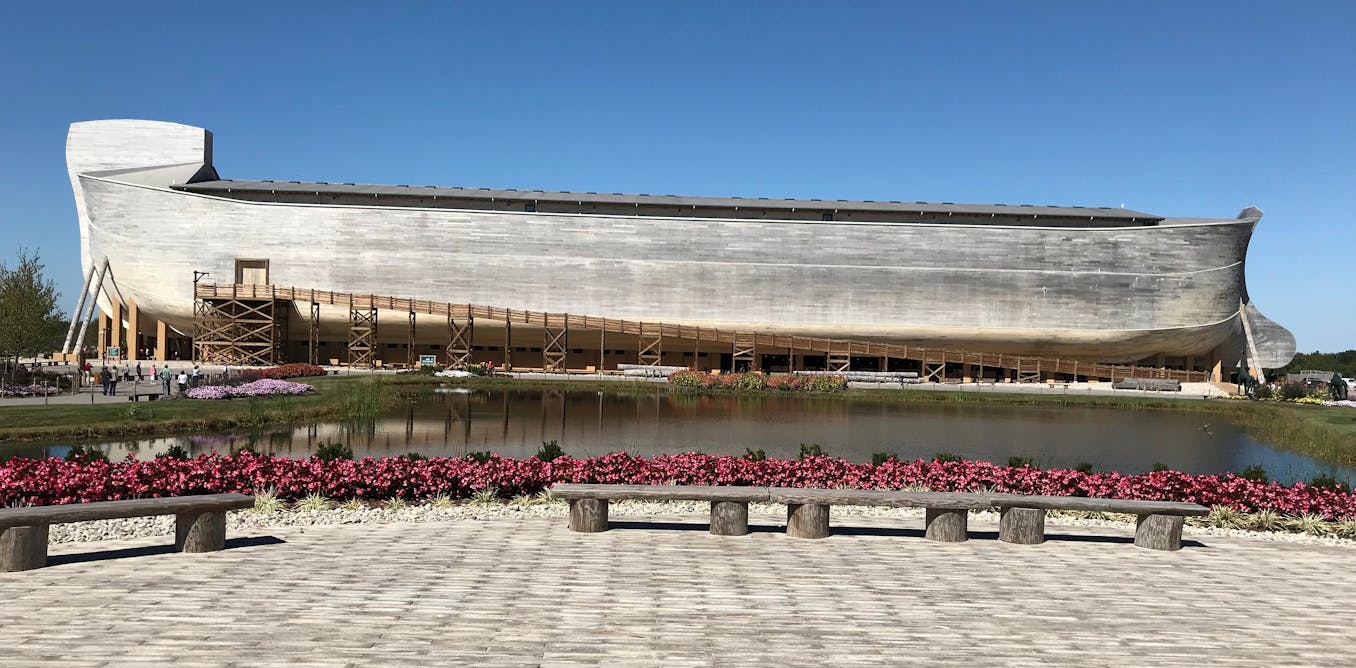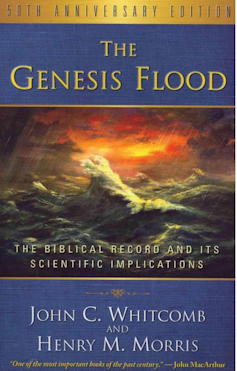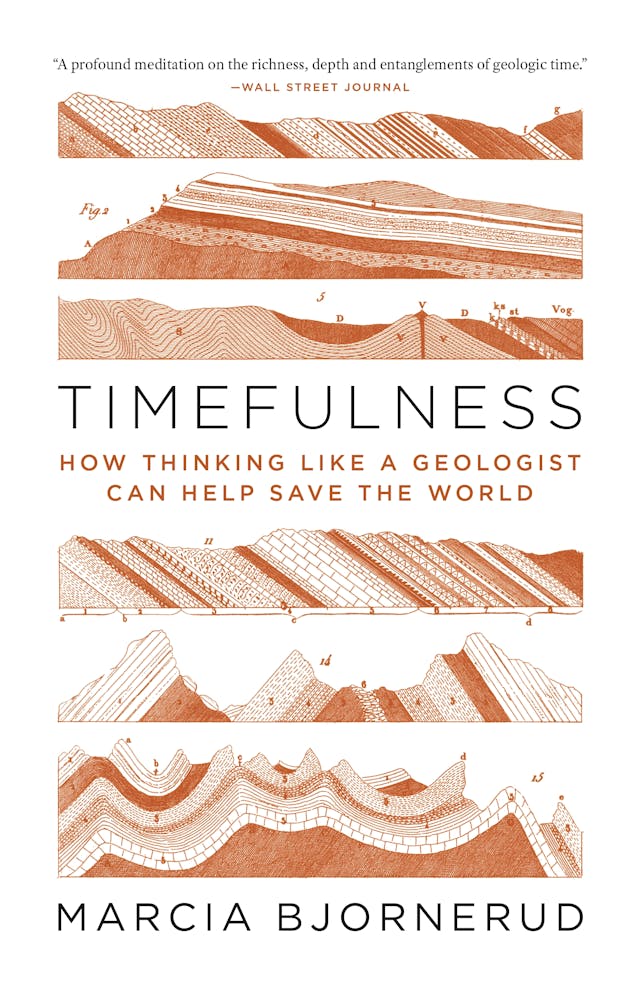Category Archives: Geology
At a popular evangelical tourist site, the image of a ‘wrathful God’ appeals to millions
Susan L Trollinger, University of Dayton and William Trollinger, University of Dayton
The Ark Encounter, an evangelical theme park located near Williamstown, Kentucky, has welcomed between 4 million and 5 million visitors since its opening in July 2016. Hundreds of thousands more are sure to visit this summer.
This theme park boasts a re-creation of the story of Noah’s Ark from the Bible. As described in Genesis 6:14-16, God directed Noah to build this ark to spare eight humans and a male and female pair of every kind of creature from the flood that God was going to unleash on the world as a punishment for sin.
As scholars of fundamentalism and creationism, we have visited the Ark Encounter multiple times. We have also written a book, “Righting America at the Creation Museum,” about the ark’s companion site, the Creation Museum in Petersburg, Kentucky.
What we find particularly striking about Ark Encounter is that it is a tourist site devoted to emphasizing – with great specificity – the wrathful nature of God and the eternal damnation that awaits unrepentant sinners.
What is Ark Encounter’s argument?
According to Answers in Genesis, the fundamentalist organization that launched Ark Encounter, and its CEO, Ken Ham, Ark Encounter is a centerpiece of AiG’s mission to “expose the bankruptcy of evolutionary ideas and bedfellow: a ‘millions of years old’ earth (and even older universe).”
So, according to AiG, when Genesis 1 says God created the Earth in six days, it literally means six 24-hour days. Similarly, when the Bible says Adam and Eve were created on the sixth day and gives details about their descendants and how long they lived, this is interpreted as recounting real history. And all of this means that, according to AiG, the Earth is “about 6,000 years old.”
While scientists have estimated the Earth to be about 4.5 billion years old, AiG counters by claiming that radiometric dating is not reliable. Instead, they assert that the catastrophic biblical flood created all the geological formations that make the Earth look ancient.
Over the past few decades, this argument has become a doctrinal touchstone for many American evangelicals.
An enormous structure
We most recently visited the Ark Encounter on March 15, 2022. Measuring 510 feet (155 metres) long, 85 feet (25 metres) wide, and 51 feet (15 metres) high, the Ark Encounter is, to quote one visitor we overheard, “so huge!”
After purchasing tickets that cost US$54.95 per adult, we and other visitors boarded buses and made the ascent up a long hill. Getting off the bus, we walked to the Ark, keenly aware of how small we were in relation to this ginormous structure.
Read the rest of this entryWhy creationism bears all the hallmarks of a conspiracy theory
A friend asked me why I bother about creationism. This article spells out my reasons. It has had some 150,000 reads since first published in The Conversation in February, and has been featured in Snopes and Yahoo! News, and attacked by Ken Ham and Bodie Hodge of Answers in Genesis, Jake Hebert Ph.D [sic] at the Institute for Creation Research, and others.

Many people around the world looked on aghast as they witnessed the harm done by conspiracy theories such as QAnon and the myth of the stolen US election that led to the attack on the US Capitol Building on January 6. Yet while these ideas will no doubt fade in time, there is arguably a much more enduring conspiracy theory that also pervades America in the form of young Earth creationism. And it’s one that we cannot ignore because it is dangerously opposed to science.
In the US today, up to 40% of adults agree with the young Earth creationist claim that all humans are descended from Adam and Eve within the past 10,000 years. They also believe that living creatures are the result of “special creation” rather than evolution and shared ancestry. And that Noah’s flood was worldwide and responsible for the sediments in the geologic column (layers of rock built up over millions of years), such as those exposed in the Grand Canyon.

Such beliefs derive from the doctrine of biblical infallibility, long accepted as integral to the faith of numerous evangelical and Baptist churches throughout the world, including the Free Church of Scotland. But I would argue that the present-day creationist movement is a fully fledged conspiracy theory. It meets all the criteria, offering a complete parallel universe with its own organisations and rules of evidence, and claims that the scientific establishment promoting evolution is an arrogant and morally corrupt elite.
This so-called elite supposedly conspires to monopolise academic employment and research grants. Its alleged objective is to deny divine authority, and the ultimate beneficiary and prime mover is Satan.
Creationism re-emerged in this form in reaction to the mid-20th century emphasis on science education. Its key text is the long-time best seller, The Genesis Flood, by John C Whitcomb and Henry M Morris. This provided the inspiration for Morris’s own Institute for Creation Research, and for its offshoots, Answers in Genesis and Creation Ministries International. [Note added: Ken Ham points out in his rebuttal that Answers in Genesis arose independently of the Institute for Creation Research, and that his article concerning denial of divine authority, cited in the previous paragraph and below, does not mention Satan by name.]
Ken Ham, the founder and chief executive of Answers in Genesis, is also responsible for the highly lucrative Ark Encounter theme park and Creation Museum in Kentucky. As a visit to any of these websites will show, their creationism is completely hostile to science, while paradoxically claiming to be scientific.
Demonising and discrediting
These are common conspiracy theory tactics at play. Creationists go to great lengths to demonise the proponents of evolution, and to undermine the overwhelming evidence in its favour.
There are numerous organisations, among them Biologos, the American Scientific Affiliation, the Faraday Institute, and the Clergy Letter Project, which describes themselves as “an endeavour designed to demonstrate that religion and science can be compatible”, that is, promoting evolution science within the context of religious belief. Even so, creationists insist on linking together the separate topics of evolution, materialist philosophy, and the promotion of atheism.
According to Answers in Genesis, evolution science is a work of Satan, while former US Congressman Paul Broun has described it as “a lie straight from the pit of hell”. When he said that, by the way, he was a member of the House of Representatives Committee on Science, Space, and Technology.
Like other conspiracy theorists, creationists immunise themselves from fact-based criticism. They label the study of the past as based on unprovable assumptions, thus disqualifying in advance the plain evidence of geology.
They then attack other evidence by focusing on specific frauds, such as Piltdown man – a hoax skeleton purportedly of a missing link between humans and other apes that was debunked more than 60 years ago – or the dinosaur-bird amalgam “Archaeoraptor”, discredited by sharp-eyed scientists before ever making it into the peer-reviewed literature (although not before making it into National Geographic).
One favourite target is Ernst Haeckel, whose pictures of embryos, published in 1874, are now considered to be seriously inaccurate. However, they do correctly draw attention to what most matters here: the features shared during development by different organisms – including humans – such as gill arches, a long tail, and eyes on the side rather than the front of the head, confirming they have a common ancestry.
Haeckel’s name appears on the Answers in Genesis website 92 times. He is also the subject of a lengthy chapter in Jonathan Wells’ Icons of Evolution; Science or Myth?. This book, which even has its own high school study guide, was what first convinced me, back in 2013, that creationism was a conspiracy theory.

More from The Conversation’s Expert guide to conspiracy theories here.
It is a splendid example of creationist tactics, using long-rectified shortcomings (such as those in early studies on Darwinian evolution in peppered moths, in response to changing colours following reduced pollution) to imply that the entire science is fraudulent. Wells has a real PhD in biology, a PhD acquired with the specific goal of “destroying Darwinism” – meaning evolution science – from the inside.
Wells is a senior fellow at the Discovery Institute, a conservative thinktank which promotes creationism under the banner of “Intelligent Design”, and is also linked to other conspiracy theories, such as claims that the consensus on climate change is bogus, and that last November’s US presidential election was stolen. An article by a senior fellow at the Discovery Institute on the subject has now being removed from its website, but can be found here.

What next?
Conspiracy theories are always driven by some underlying concern or agenda. The theory that Obama’s birth certificate was a forgery, or that the 2020 US election was stolen, are about political legitimacy and will fade as the politicians promoting them fade from memory. The idea that COVID-19 does not exist is proving a little harder to dislodge, but scientists, such as those behind Respectful Insolence, are organising to fight back on science denial and misinformation.
I fear that the creationist conspiracy theory will not be so short-lived. It is driven by a deep-seated power struggle within religious communities, between modernists and literalists; between those who regard scripture as coming to us through human authors, however inspired, and those who regard it as a perfect supernatural revelation. And that is a struggle that will be with us for a long time to come.
Timefulness: How thinking like a geologist can help save the world (review; long)
 Timefulness: How thinking like a geologist can help save the world, Marcia Bjornerud, Princeton University Press, 2018/2020
Timefulness: How thinking like a geologist can help save the world, Marcia Bjornerud, Princeton University Press, 2018/2020
There are many excellent overviews for the general reader of how life on Earth has changed over time (see, for a recent example, Neil Shubin’s Some Assembly Required, which I reviewed here recently. The history of the Earth itself has not been so well served, and Timefulness; How Thinking Like a Geologist Can Help Save the World, by Marcia Bjornerud, Professor of Geology and environmental Sciences at Lawrence University, is a welcome and timely addition to this badly under-represented genre. [1] The book is beautifully written, in plain language, with complex ideas explained with great simplicity and the use of strikingly appropriate verbal imagery. Behind this transparency of language lies a deep love and knowledge of her subject. The book should appeal to anyone looking for an overview of the Earth as the abode of life, or a perspective on our place in time, and how recklessly we are compressing the tempo of natural change.
The author presents her book as an argument for what she calls timefulness, the perception of ourselves as living in and constrained by time, of time itself as having both extension and texture, of the acceptance of our own mortality, and of our own responsibilities. This she sees as severely lacking in our society. We expect people to know something about distances on the map, but Read the rest of this entry
What does Mt St Helens teach us about Noah’s flood? Almost nothing.
Young Earth Creationists (YECs) argue from the rapid and dramatic events observed at the Mt St Helens 1980 eruption to the conclusion that the Earth’s geological record, as displayed for example at the Grand Canyon, could be the results of the even more dramatic events associated with a biblical worldwide flood. Geochristian, in the post I link to below, dismantles specific examples of this claim, and goes on to challenge the view that the Bible describes Noah’s Flood as a worldwide catastrophe anyway. Illustration: Step Canyon, Mt St Helens; Google Earth via Geochristian
Regarding geology, the YEC arguments derive their rhetorical power from the all-or-nothing thinking that runs through all their positions. They claim that Mt St Helens demonstrates the correctness of catastrophism over geological gradualism. If all this much can happen so quickly, why assume that the Earth’s deep geology really required deep time? If the flowing ash and mud from Mt St Helen’s shows lamination and cross bedding, does that not destroy the geologist’s argument that the lamination and cross bedding of shales and sandstones are the result of slow deposition? If in a matter of days snowmelt carved a canyon in the Mt St Helens deposits, would not the waters of a year-long flood have sufficed to carve out the Grand Canyon? If the Mt St Helens eruption rapidly uprooted and re-deposited large number of trees, could not the Earth’s fossil fuel deposits have been formed in the same manner?
Geochristian discusses each of these claims in detail (spoiler; none of them will stand up to examination). What I want to point out here is how much they all have in common. They all depend on imposing absolute either/or divisions on reality, cherry picking similarities and ignoring differences, and imposing the simplest of models on complex reality. The dispute between catastrophism and gradualism, although repeatedly revived by creationists (see e.g. here https://www.allaboutcreation.org/catastrophism-versus-uniformitarianism-faq.htm ) was pronounced dead by TH Huxley, “Darwin’s bulldog”,in his Presidential Address to the Geological Society in 1869 https://mathcs.clarku.edu/huxley/SM3/GeoAd69.html. It’s simply a matter of perspective. Catastrophic events do happen from time to time, but not very often, giving the impression of gradualism over long periods of time. Cross bedding can occur catastrophically, in well-understood special circumstances, but geologists have never had any difficulty in distinguishing between what is found in sudden volcanic outpourings and the completely different wind-blown cross bedding observed in desert sandstones, including ironically the Coconino Sandstone within the Grand Canyon itself. Canyons such as Mt St Helens Step Canyon can indeed form very rapidly in uncompacted sediments, but the Step Canyon is straight, and carved on a steep slope through soft debris, while Grand Canyon has bends and is carved through extremely hard rock by a river flowing over a plateau with, overall, a gentle gradient. And the tree debris from Mt St Helens bears no resemblance, either in texture or in amount, to the world’s coal fields.
Next, Geochristian attacks the YEC interpretation of Genesis. In particular, the word “eretz”, describing the territory immersed in the flood, can mean either the Earth, or a more limited region. Here his motivation is to preserve faith in the text, while rebutting the interpretation that requires the flood to be worldwide. My own approach would be rather different. In the biblical narrative, God sets out to destroy mankind, apart from the virtuous relic represented by Noah and his family. This could hardly have been accomplished by a merely local flood, though one could well argue that the author(s) of Genesis did not make a clear mental distinction between local and worldwide. However, the entire problem disappears if you regard the Genesis narrative (or, rather, fused narratives) in context within a much more ancient Mesopotamian literature, and I argue https://paulbraterman.wordpress.com/2018/11/12/noahs-flood-and-how-to-talk-to-creationists-about-it/ that this is actually more respectful of the text than supernaturalist literalism. However, in my experience discussions between those who do, and those who do not accept a supernatural origin for Scripture are rarely productive.
So why I am I, an unbeliever, re-blogging Geochristian’s material at all? Because as I see it, the crucial gulf is not between religious believers and unbelievers, but between those who are willing to accept reality in all its complexity, and those who prefer to impose their own dogma. And this does not affect only such matters as evolution and the age of the Earth, but such intensely practical matters as conservation, global warming, the regulation of market-based economies, and, right now, our reaction to one particular virus that happens to have mutated and evolved.
h/t Michael Roberts https://michaelroberts4004.wordpress.com/2020/05/19/what-does-mt-st-helens-teach-us-about-noahs-flood-almost-nothing/
All I got from Mt St Helens (MSH) in the days following its May 18, 1980 eruption was a few pretty sunsets. I was an undergraduate student in my first year at the University of Utah, and most of the ash cloud passed far north of Salt Lake City. MSH became more significant for me a few years later as a geology graduate student at Washington State University, where my research project involved analysis and correlation of Cascade Range tephra (volcanic ash) layers buried at various levels in the Quaternary Palouse Loess of eastern Washington. Some of these tephra layers correlated to ancient eruptions of MSH, dated around 13,000 and 36,000 years ago.
Fortieth Anniversary
 Credit: USGS, Robert Krimmel, public domain
Credit: USGS, Robert Krimmel, public domain
Due in part to easy accessibility, the 1980 eruptions of MSH have been studied more closely than just about any other explosive volcanic eruption in history. Geologists have learned…
View original post 2,319 more words
Where rocks touch: geologic contacts
Another delightful posting from my friend Marli Miller.Thanks, Marli. I’ve blogged here earlier myself about the famous unconformity at Siccar Point, and the depositional contact at the Giants Causeway between a later lava flow, and the paleosol formed by weathering of the one before it.
Geologic contacts are the surfaces where two different rocks touch each other –where they make contact. And there are only three types: depositional, intrusive, or fault. Contacts are one of the basic concerns in field geology and in creating geologic maps –and geologic maps are critical to comprehending the geology of a given area. For those of you out there who already know this stuff, I’ll do my best to spice it up with some nice photos. For those of you who don’t? This post is for you!
Depositional contacts are those where a sedimentary or volcanic rock was deposited on an older rock (of any type). Intrusive contacts are those where igneous rocks intrude older rock (of any type). Fault contacts are… faults! –surfaces where two rocks of any type have moved into their current positions next to each other along a fault.
In a cross-sectional sketch they may…
View original post 962 more words
Shaping of Landscape: A primer on weathering and erosion
Landscape as process, beautifully illustrated. Students with Marli Miller as instructor are fortunate indeed
Most of us love landscapes –and many of us find ourselves wondering how they came to look the way they do. In most cases, landscapes take their shape through the combined processes of weathering and erosion. While weathering and erosion constitute entire fields of study unto themselves, this primer outlines some of the basics—which pretty much underlie all the further details of how natural processes shape landscapes.
 Aerial view of incised meanders of Green River, Utah.
Aerial view of incised meanders of Green River, Utah.
Two definitions: weathering describes the in-place breakdown of rock material whereas erosion is the removal of that material. Basically, weathering turns solid rock into crud while erosion allows that crud to move away.
Weathering
Weathering processes fall into two categories: physical and chemical. Physical weathering consists of the actual breakage of rock; any process that promotes breakage, be it enlargement of cracks, splitting, spalling, or fracturing, is a type of physical weathering. Common examples…
View original post 1,259 more words
Evolution of the River Nile
Reblogging from Steve Drury at wileyearthpages. In an earlier post (How to learn from creationists), I mentioned the case of the buried Nile canyon as one where I had learnt from answering creationists’ questions. This piece gives much more detailed interesting information, and I am surprised (not for the first time) to learn how young great river systems are in their present form.
The longest river in the world, the Nile has all sorts of riveting connotations in terms of archaeology, Africa’s colonial history, the romance of early exploration and is currently the focus of disputes about rights to its waters. The last stems from its vast potential for irrigation and for hydropower. It is probably the most complex of all the major rivers of our planet because it stretches across so many climatic zones, topographic systems geological and tectonic provinces. Mohamed Abdelsalam of Oklahoma State University, who was born in the Sudan and began his career at the confluence of the White and Blue Nile in its capital Khartoum, is an ideal person to produce a modern scientific summary of how the Nile has evolved. That is because he has studied some of the key elements of the geology through which the river and its major tributaries travel, but most of all…
View original post 674 more words
Grand Canyon Unconformities –and a Cambrian Island
I have discussed the Grand Canyon myself at https://paulbraterman.wordpress.com/2018/03/09/why-science-needs-philosophy-cont-and-why-it-matters-with-examples-from-geology/ , and strongly recommend this beautifully written and illustrated guide to its unconformities
A prominent ledge punctuates the landscape towards the bottom of the Grand Canyon. It’s the Tapeats Sandstone, deposited during the Cambrian Period about 520 million years ago, when the ocean was beginning to encroach on the North American continent, an event called the Cambrian Transgression. Above the ledge, you can see more than 3000 feet of near-horizontal sedimentary rocks, eroded into cliffs and slopes depending on their ability to withstand weathering and erosion. These rocks, deposited during the rest of the Paleozoic Era, are often used to demonstrate the vastness of geologic time–some 300 million years of it.
 View of the Grand Canyon from the South Rim trail. Arrows point to the Tapeats Sandstone.
View of the Grand Canyon from the South Rim trail. Arrows point to the Tapeats Sandstone.
But the razor-thin surface between the Tapeats and the underlying Proterozoic-age rock reflects the passage of far more geologic time –about 600 million years where the Tapeats sits on top the sedimentary rocks of the Grand…
View original post 1,081 more words
When dinosaurs roamed the Western Isles
Quite a challenge, I expect, to the local Free Presbyterians.
My friend Kim Johnson commented on the strange appearance of the footprints, Steve Drury (author of the blog of which this is just an annotated repost) referred me to Paige Depolo, senior author of the paper on which Steve’s post is based, and Paige replied as follows:
When it comes to the depositional environment, the tracks were formed in a low-energy lagoon and are generally preserved today as impressions into shaley limestone. Later, additional limestone layers were laid down at the site and in-filled the impressions. Those layers form the casts that we can still observe for some of the tracks today. In some cases at this site, the cast remains while the surrounding impression which it was originally infilling has been almost completely eroded. These rocks were deposited during the Middle Jurassic. Later, likely during the Paleogene, a sill was intruded immediately below the track bearing layer and the surrounding rocks were baked. The low-level contact metamorphism of the track-bearing layers definitely makes for some interesting looking exposures!
h/t Kim and Steve, and many thanks to Paige

The Isle of Skye off the northwest coast of Scotland is known largely as a prime tourist destination, such as Dunvegan Castle with a real clan chief (The MacLeod of MacLeod) and its Faerie Flag; Britain’s only truly challenging mountains of the Black Cuillin; and, of course, the romantic connection with the Young Pretender, Charles Edward Stuart and his escape, in drag, from the clutches of the Duke ‘Butcher’ Cumberland, hence the Skye Boat Song. Geologists know it best for its flood basalts with classic stepped topography and the exhumed guts of a massive central volcano (the Cuillin), relics of the Palaeocene-Eocene (62 to 54 Ma) North Atlantic Large Igneous Province. The spectacular Loch Coruisk, a glacial corrie drowned by the sea, exposes the deepest part of the main magma chamber. It is also the lair of Scotland’s lesser…
View original post 335 more words




